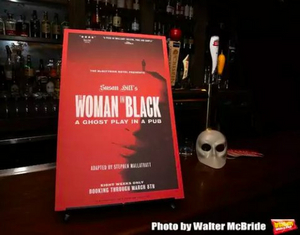Review Roundup: THE WOMAN IN BLACK at the McKittrick Hotel - What Did the Critics Think?

The McKittrick Hotel presents the original production of long-running West End play The Woman In Black. Previews began in the hotel's hidden pub The Club Car on January 8, with an official opening on January 23, 2020.
The Woman in Black tells the story of a young lawyer who stumbles upon a small town with a grave secret. Stephen Mallatratt's ingenious stage adaptation comes dramatically alive in Robin Herford's gripping production of Susan Hill's acclaimed ghost story.
Director Robin Herford reunites with actors Ben Porter and David Acton, who both starred in the London stage production, to reprise their roles for this limited engagement at The McKittrick. There, The Club Car provides the perfect setting to weave the story among and around its audience.
Let's see what the critics are saying...
Ben Brantley, The New York Times: This journey into fear - set in a Britain still shaking off the picturesque dust of the Victorian era - is achieved with little more than some sheets, a flashlight, a trunk, a few sticks of furniture, ambient sound effects (by Sebastian Frost) and lighting (by Anshuman Bhatia) that regularly plunges the audience into darkness. This means that, with our nerves conditioned to be exposed, we become acutely aware of every sound and movement around us. And, yes, people jump and shriek when the title character suddenly shows up in their midst.
Breanne L. Heldman, EW: When the first jump-scare happens (the mysterious locked door swings open!), the audience reacted much as I did in music class way back when. And like that, they began to anticipate and delight in more, similar moments throughout the show, down to its final seconds. Acton and Porter perform an impressive two-hander, with Acton taking on countless characters throughout (and Porter sticking to the thespian and young Kipps). Their comfort and trust is evident as they weave Kipps' tale and move around the sparse stage and through the unique space.
Thom Geier, The Wrap: The production relies on a minimum of props - a wicker basket is employed as a desk, a bed and a carriage - and the most basic sound and lighting design (by Sebastian Frost and Anshuman Bhatia, respectively). But the intimacy of the space, and Porter's decision to wander among the audience as he puzzles out the mysteries of the haunted home where he must work, contributes a lot to the piece's effectiveness. It's the theatrical equivalent of a ghost story told around a campfire, this time by professionals rather than your scout troupe leader. And while there are no flashlights, or s'mores, there is booze. Or should I say spirits?
Sandy Macdonald, Theater News Online: I took the precaution of taking a bodyguard to this supposed thriller - someone tall, whose broad shoulders I could hide behind. I scare all too easily - but experienced nary a frisson in the course of this rather tame tale, a West End staple (30 years!) derived from a 1983 pseudo-Victorian novel. Barring a couple of blood-curdling screams (roughly the decibel level of the Q train careening toward Canal Street), there's little to induce a startle reflex.
Reader Reviews



